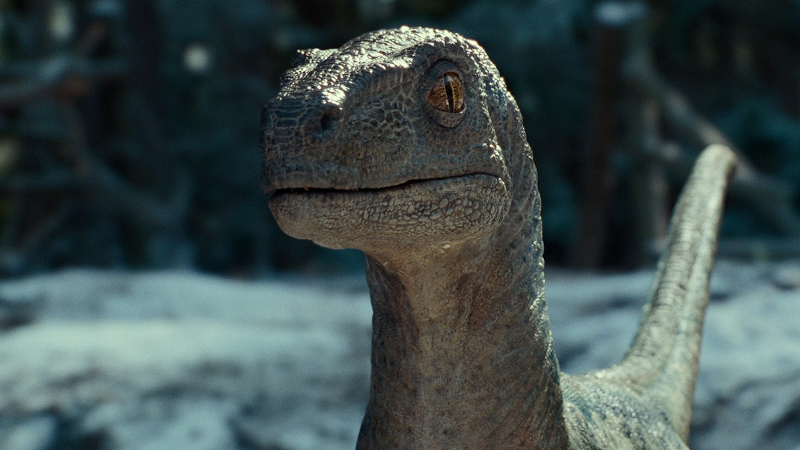Director – Colin Trevorrow – 2022 – US – Cert.12a – 148m
***
Sixth Jurassic movie promises then dumps a plot where humans and dinosaurs co-exist in the modern world and instead heads for a secluded valley where numerous dinosaurs are kept by a dodgy corporation – out in cinemas on Friday, June 10th
There’s a long tradition in cinema of putting dinosaurs alongside humans, as if the dinosaurs on their own wouldn’t be enough to bring in audiences. This is nonsense of course: look no further than the TV series Walking With Dinosaurs (1999), Walt Disney’s Fantasia (segment directors: Bill Roberts, Paul Satterfield, 1940) or The Animal World (effects: Willis O’Brien, Ray Harryhausen, 1956), and the high regard in which they’re held, for proof.
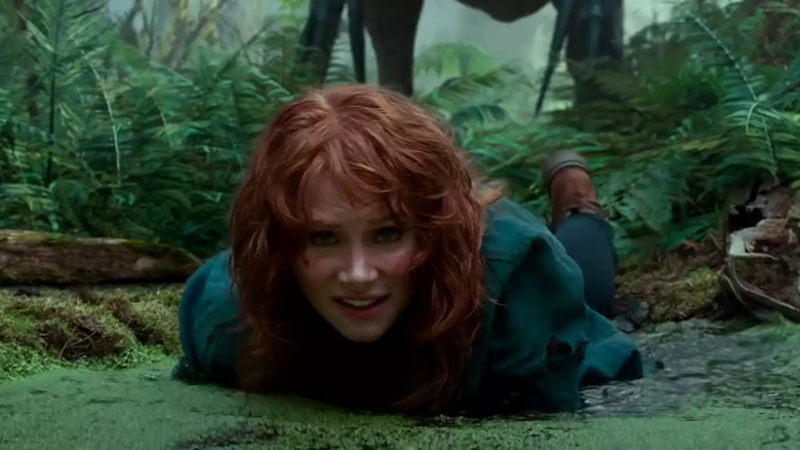
The genius of Jurassic Park (Steven Spielberg, 1993) was to reconstruct the dinosaurs from their DNA, providing a much better reason to put both species side by side than the lost plateau of The Lost World (effects: Willis O’Brien, 1925), the lost island of King Kong (effects: Willis O’Brien, 1933), the lost valley of The Valley Of Gwangi (effects: Ray Harryhausen, 1969) or the cavemen and dinosaurs of One Million Years B.C. (effects: Ray Harryhausen, 1966).
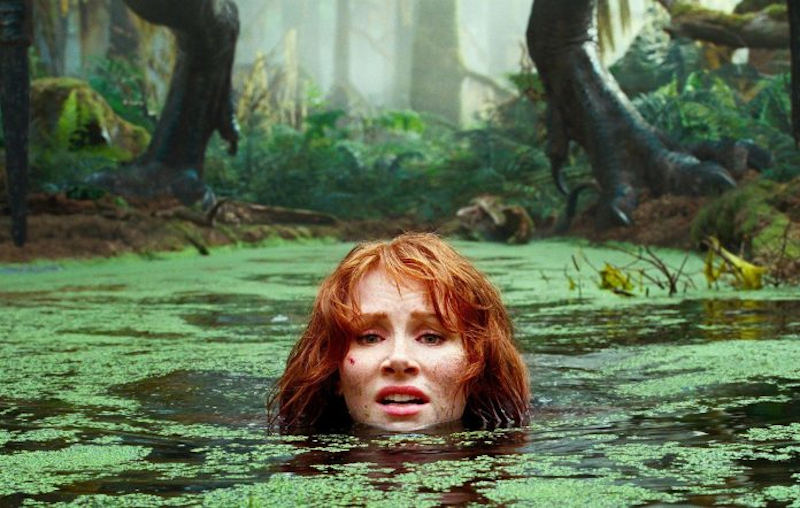
Jurassic Park isolated its dinosaurs on an island and the franchise has followed that model (the Lost World / King Kong model) even if the fifth franchise film Jurassic World: Fallen Kingdom (J.A. Bayona, 2018) upped the ante at the end by allowing dinosaurs to escape into the wider, modern world.
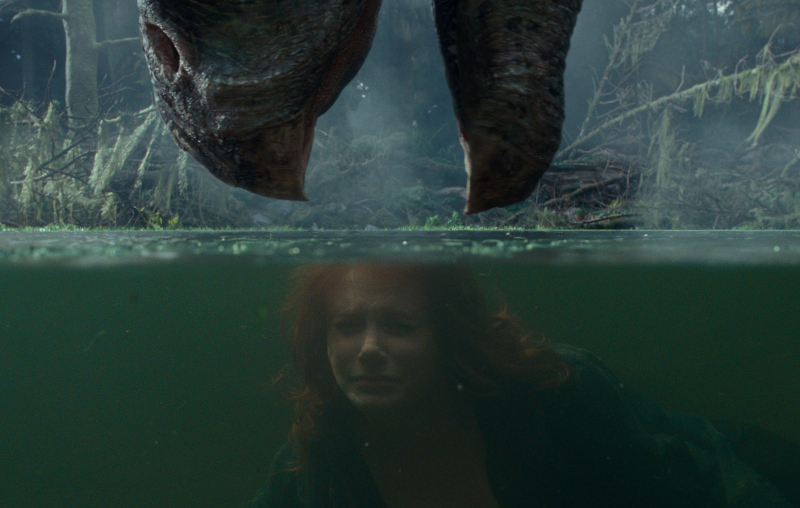
Thus, the new film opens with a US TV news report of dinosaurs living in our world, some of which previously appeared in the closing credits of the Jurassic World short Battle At Big Rock (Colin Trevorrow, 2019, available to view online…
…which features an allosaurus, a triceratops and human visitors to a national park. Among the news footage, a young girl crying whilst being chased around a farmyard pen by a clutch of compthognasus, a car driving off a mountain road to avoid a swinging stegosaurus tail, and doves thrown into the air at a wedding only to be devoured by swooping pterodactyls. Brand new is a delicious sequence of the flying reptiles nestling atop an urban skyscraper in what could well be San Francisco, echoing New York in Q: The Winged Serpent (Larry Cohen, 1982) and the original King Kong.
So now we’re set up for a movie where humans and dinosaurs co-exist in the modern world. At this point, my personal inner dinosaur nerd is really excited at this prospect, which the trailers and the opening of the film suggests Dominion is going to deliver.
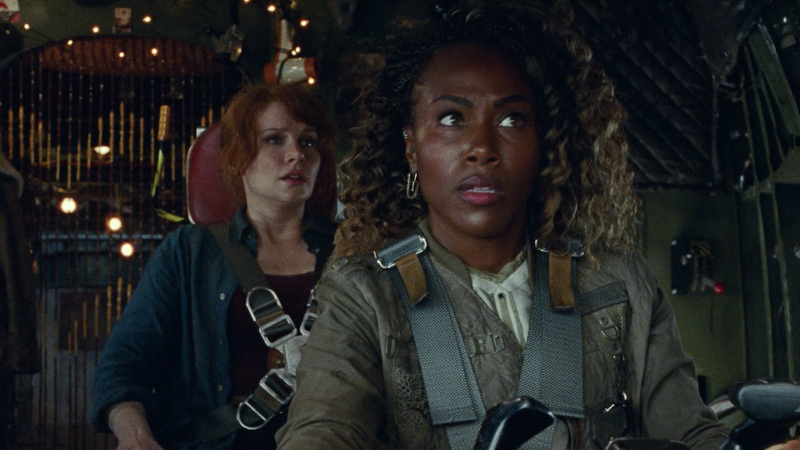
And then, wouldn’t you know it, just as it’s getting going, the screenplay by Trevorrow and co-writers Emily Carmichael and Derek Connolly throws all this out as everyone goes back to a cut-off, secluded world following the formula of the last five Jurassic movies. Technically, it’s a secluded valley not an island, but it most definitely feels like an island since the only way to get there is by plane with the cargo landing area looking suspiciously like a harbour. This device worked a treat in the first movie and creaked a bit through a couple of sequels (Jurassic Park III – Joe Johnston, 2001 – is, actually, surprisingly effective), an enjoyable reboot and a generally dire fifth film.
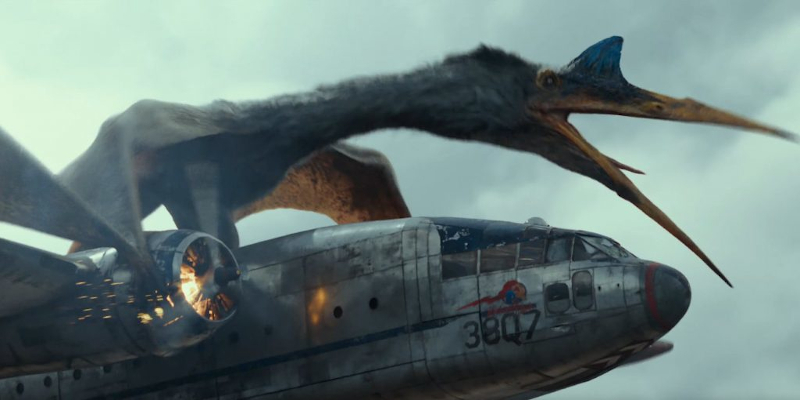
But by now, this idea is now definitely past its sell-by date. So why bring it back? This decision effectively dumps the the dinosaurs in our world plot, and it feels like a huge cheat. No dinosaurs encountering humans in rural communities. No dinosaurs encountering humans in urban areas. We was robbed.
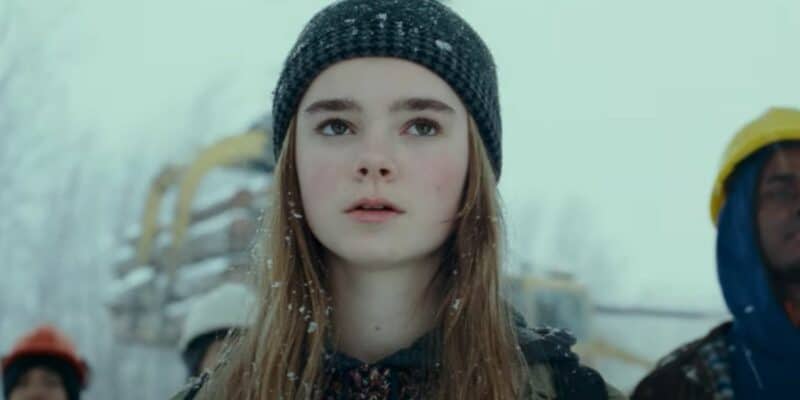
In addition, somewhat unbelievably, Dominion throws in two other plots. One, unsurprisingly, is a continuation of the last two Jurassic World films, with dinosaur trainer Owen Grady (Chris Pratt) and former administrator Claire Dearing (Bryce Dallas Howard) living together in the isolated, snow-covered, rural North looking after Maisie (Isabella Sermon), a cloned teenager from Jurassic World: Fallen Kingdom.
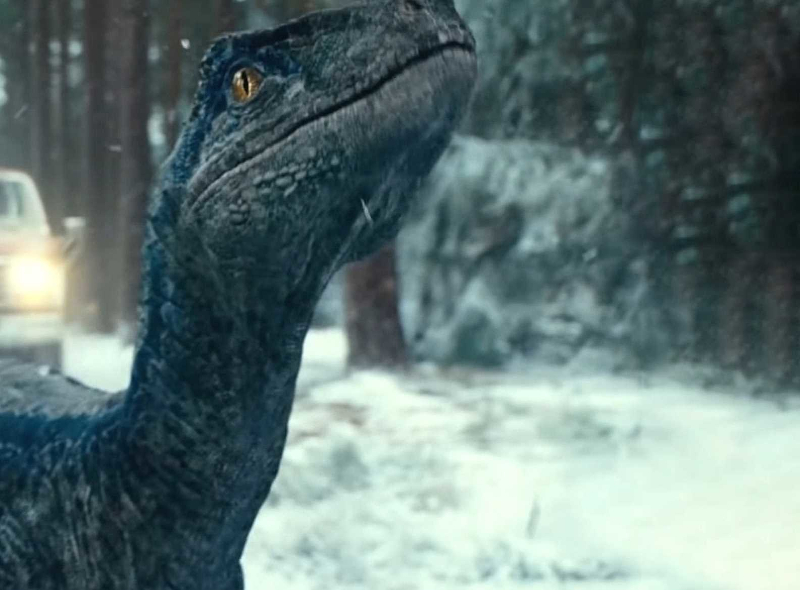
Not far away is Blue, the sole surviving velociraptor trained by Grady, who has given birth to an infant the humans have christened Beta. The two adults are fearful that someone will kidnap Maisie for research purposes, but the rebellious teenager won’t have it and keeps sneaking off the the nearest outpost of civilisation, including a scenario where everyone (including the cinema audience) marvels at a passing sauropod.
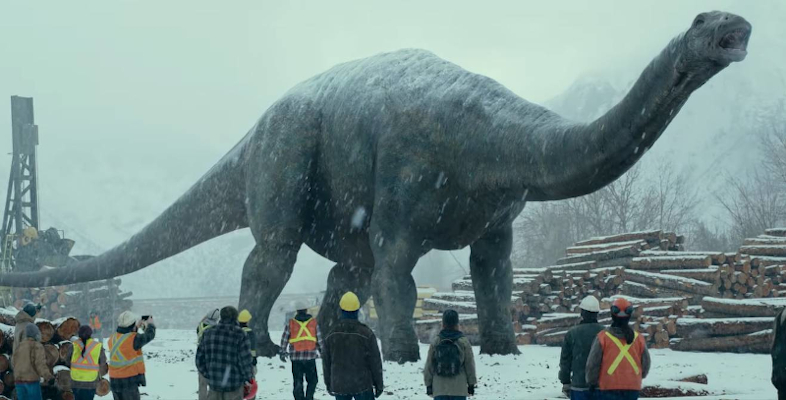
And then poachers turn up, and kidnap both Maisie and Beta. For delivery to a secluded location accessible only by aircraft…

The second additional plot comes from somewhere out of left of field and is so interesting you wish executive producers Spielberg and Trevorrow had used it for an entire film and not bothered with anything else, and perhaps kept the let’s go back to a secluded area plot for a further movie. They didn’t do that because it doesn’t contain any dinosaurs (except coincidentally, in passing, with some nice ideas about activists releasing dinosaurs that have been captured and are being held in inhumane conditions not unlike battery hens in small enclosed cages in a warehouse somewhere).

In the dinosaurs’ place is instead a plague of giant, genetically modified giant locusts individually about two feet in length and seen in West Texas. These eat all grain except that developed by the less than transparent Biosyn corporation, the people who (you’ve guessed it) own the island to which Beta and Maisie are being taken in the first additional plot.

Head of the activists is Dr. Ellie Sattler (Laura Dern) from the original Jurassic Park who pays a visit to a palaeontological dig (a lot like the one in the first film) where Dr. Alan Grant (Sam Neill), also from that original, is working. She reckons that if she can get to the island and retrieve a sample of DNA from a modified locust, she can prove what the bad corporation is up to and get them shut down. She persuades Grant to tag along.
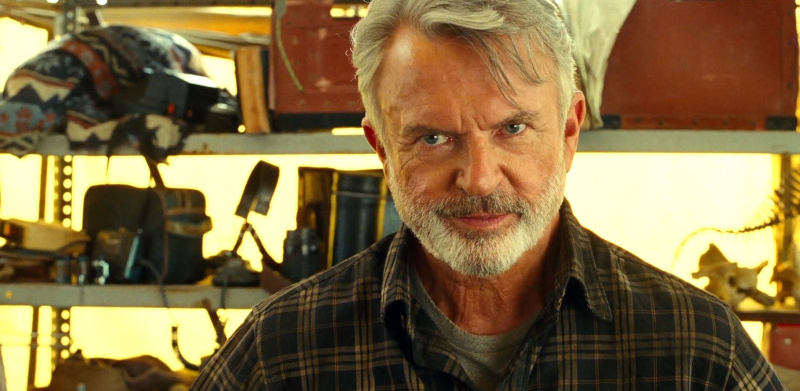
The characters are familiar, and just as enjoyable as in the first film, but the story is fresh and original here. The problem from the franchise’s point of view is, yes, there are prehistoric beasties (locusts), but no dinosaurs. That said, I would have loved to have seen this plot strand developed into a stand-alone movie, dinosaurs or no dinosaurs, and the three quarters or an hour or so devoted to it intermittently in this film is the best thing here (as it criss-crosses the other two plots, albeit mostly the Blue / Maisie one since the dinosaurs in our world plot sadly gets largely sidelined). Watch out for the sequence where the pair, in protective clothing, get trapped in a Biosyn lab with a swarm of giant locusts.
Back in the first additional plot, Claire and Owen’s pursuit of the kidnappers leads to an action sequence in Malta that with a similar yellow and brown palette and Chris Pratt on a motorbike feels a lot like the Italian chase sequences in the Bond movie No Time To Die (Cary Joji Fukunaga, 2021). Even though both films were bankrolled by Universal, I suspect it’s likely that the makers of this film hadn’t seen that one, as it was being kept under wraps.

Nevertheless, it’s hard to imagine the three screenwriters didn’t feel they were writing something akin to a Bond movie. They have a pack of four atrociraptors (a lot like velociraptors) who have been trained to hunt to the death any creature at which a red laser beam is pointed which while it makes for exciting action sequences seems a silly idea, and not something a dinosaur nerd like me would go to the cinema to see. I feel they may have overstepped the mark a little with this idea.
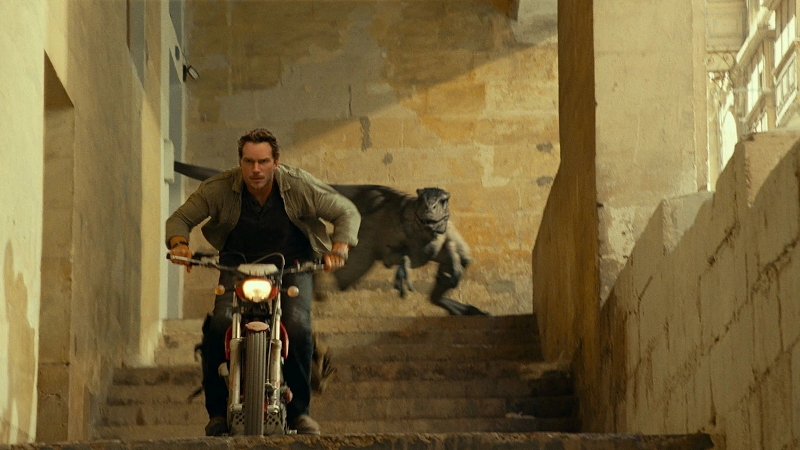
The Bond feel continues with Biosyn and its attendant high tech base which feels lifted straight out of Dr. No (1963) or You Only Live Twice (1967). Biosyn’s boss Lewis Dodgson (Campbell Scott) – one of the team of industrial thieves in Jurassic Park where the character was played by a different actor – feels like (and is just as satisfying to watch as) one of the more convincing Bond villains, complete with a nefarious plan (dominion?) to take over the world’s food supply involving giant locusts. [Ian Fleming readers will know that dangerous animals are more common to Bond adventures than you might suppose – the book of Dr. No’s climax features sequences with a nest of tarantulas, a pack of migrating crabs and a fight with a giant squid, none of which made it into the (first) Bond film.]
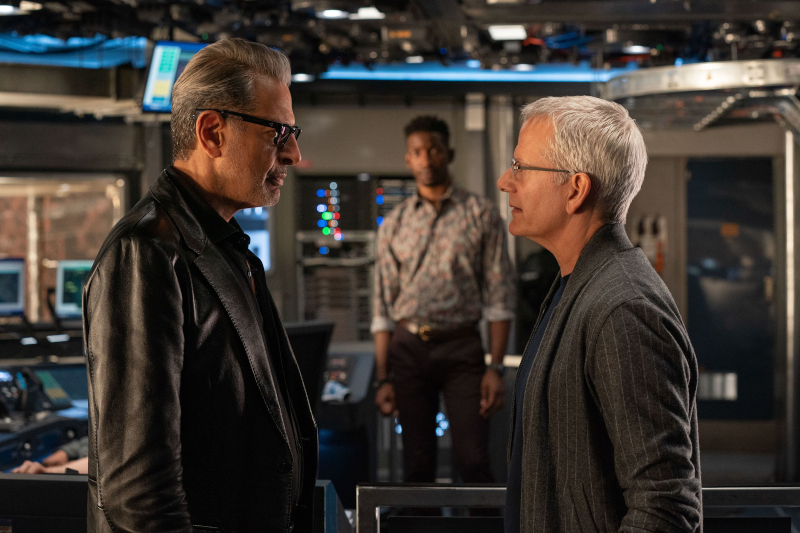
Also on hand at Biosyn is Jurassic Park’s mathematician and chaos theoretician Dr. Ian Malcolm (Jeff Goldblum) who, like Sattler and Grant, plays a key role in the locusts plot strand. All three actors are given a lot to do and it’s a pleasure to watch them do it.

Overall, there’s a lot of action involving giant or man-sized predators (including a couple displaying feathers, one of which can swim under ice) and not that much involving the herbivores. Think back to the first Jurassic Park, and it was equally fascinated by both. Somewhere along the line, the franchise seems to have largely lost the sense of awe and majesty of these creatures, which is a major flaw. Every so often, a brief vista momentarily recovers that sense, but then the film seems to lose it again.

Some of my favourite moments in the film – especially if viewed on a huge cinema screen – are brief, one off vistas, such as the one toward the end where sauropods and others wander through a lake in search of shelter from the firestorm. Some of my least favourite moments are the lazy rehashes, such as the scene with the dilophosaurus (the screechy four-foot-high creature that appears friendly until it extends its colourful neck ruff and screams at its intended prey as it stares it in the face).
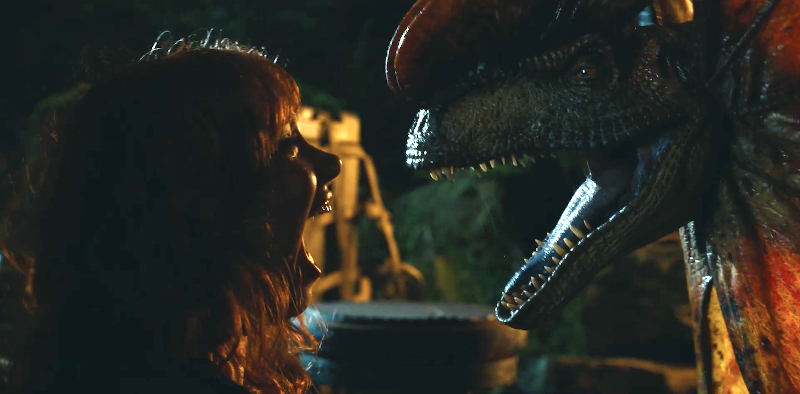
One of the most beautiful scenes in the entire film occurs early on, with mother Blue and infant Beta racing together through woodland snow, crunching underfoot as they go. It really gets to what these beautiful creatures are about, and why audiences are so fascinated by them, and I wish the film had explored more of this kind of material.
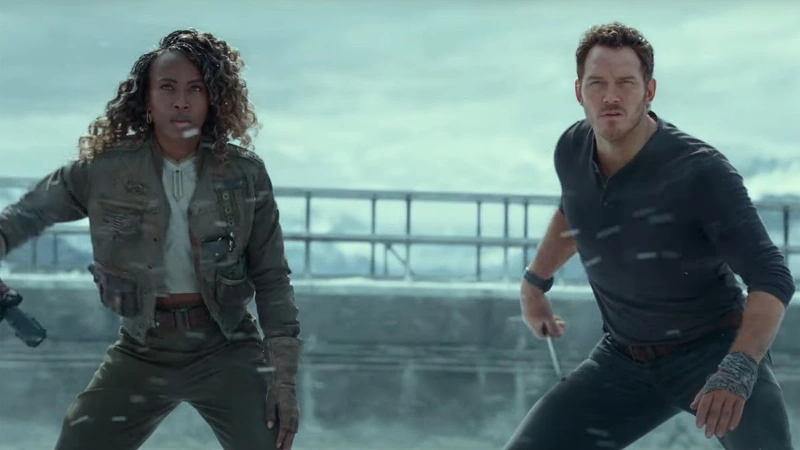
There is a lot more in here (the film is some two and a half hours long), some of it terrific, some of it less so. Certainly, you won’t ever be bored, the animatronic and visual effects are effective (you’re unlikely to be able to tell which is which) and the returning cast from the original film acquit themselves well. There are also numerous other dinosaurs, carnivores including the ever popular T. Rex plus a giganotosaurus and a therizinosaurus, not to mention flying, winged lizards and the one which swims under ice.
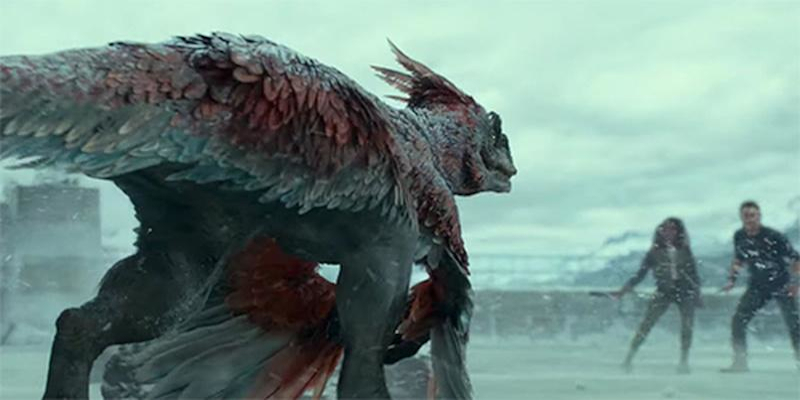
The original film remains a cinematic game-changer to this day in terms of its groundbreaking animatronic and visual effects, which is an almost impossible precedent to equal. And equal it in those game-changing terms, this new one doesn’t. Even if the sheer numbers of dinosaurs and the peerless, animatronic and visual effects work used to bring them to life by John Nolan’s crew and the Industrial Light and Magic artists is undeniably impressive.
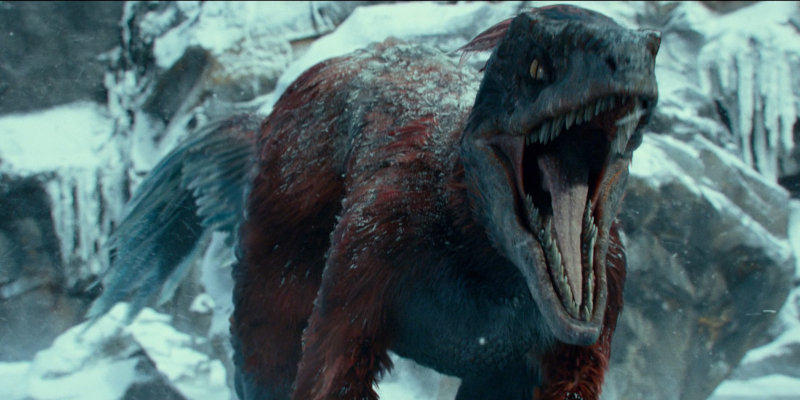
Dominion’s inventive locust plot aside, however, it’s not a patch on the original Jurassic Park (or for that matter the original Jurassic World). Throwing in more plots and dinosaurs on a hit and miss basis and falling back on tried and trusted formulae rather than pushing the boat out and trying something new is playing it safe, sadly. And there was so much potential here. I’d be lying if I said I didn’t enjoy it, and it’s undeniably enthralling in places, especially if seen on a huge screen, but overall this sixth Jurassic entry remains a huge disappointment.
If you have kids, sit down and watching the original Jurassic Park with them beforehand rather than taking them to the cinema and starting them off with this. That way, you’ll enjoy both films far more.
Jurassic World Dominion is out in cinemas in the UK on Friday, June 10th.
#jurassicworlddominion
Trailer:
Trailer 2:
